A vision statement almost sounds mystical. But it’s not supernatural, far from it. Rather, a vision statement is a foundational business document.
There’s a lot of paperwork that clutters the office of any organization, but the vision statement is unique from the rest. Often confused with a mission statement, the vision statement has a different purpose. A vision statement looks toward the future, but a mission statement talks about what the company is doing in the present.
What Is a Vision Statement?
A vision statement is a business document that states the current and future objectives of an organization. A company’s vision must align with its mission, business plan, strategic plan, and organizational culture. A vision statement isn’t only used in business; nonprofits and government offices also use them to set strategic goals.
Vision statements aren’t necessarily set in stone. They can be returned to, reviewed and revised as necessary. Any changes should be minimal, however, because a vision statement is a guideline for a company’s strategic plan, so it must be thoroughly reviewed.

Get your free
Vision Statement Template
Use this free Vision Statement Template for Word to manage your projects better.
The business vision of an organization might change over time, as companies adapt to their business environment and external factors that might affect their ability to achieve their mission. Using a SWOT analysis is a good way to gauge the internal and external factors that shape the business environment of a company.
A vision statement doesn’t have any particular length. However long it is, the vision statement is formally written and is used as a reference in company documents to serve as a guide for short and long-term strategic planning. The best way to learn about vision statements is to look at examples. We’ve gathered 25 vision statement examples from the best companies in the world to help you write your own.
What Is the Purpose of a Vision Statement?
As stated above, a vision statement is an integral part of an organization because it aligns with its mission, core values, and culture. It also guides the strategic plan because it sets future goals. Similar to a mission statement, a vision statement it’s a living document that’s referred to as a lodestar to lead a company to its next innovation and so, all the projects and programs executed by the project management office (PMO) should be aligned with it.
Related: Free Project & Tracking Templates for Excel
There are different approaches when it comes to writing a vision statement, as companies have unique core values. For example, a motivational vision statement will both motivate existing employees and also drive talent to the company. They’ll want to work at a place with a business vision that aligns with their personal values. A strong vision statement also works to help differentiate your company. All companies want to become profitable, but a company can create a unique vision statement that’s appealing to its customers and employees.
Free Vision Statement Template
Feel inspired? Ready to make your own vision statement? Download our free vision statement template for Word and start refining your vision. There’s even guiding questions to help you get started.
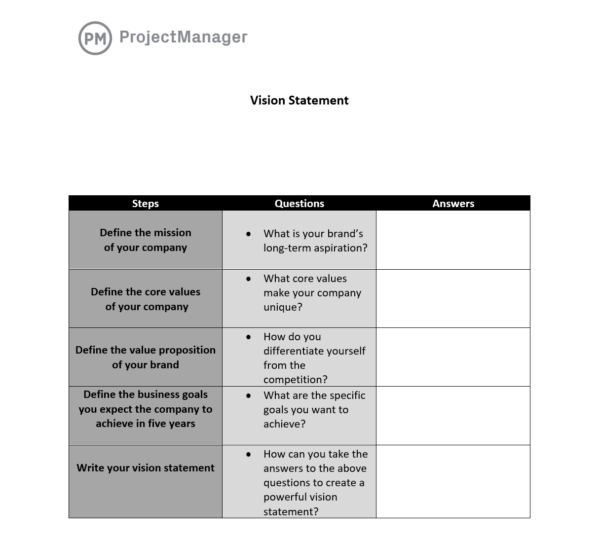
Why Is It Important to Have a Vision Statement?
Vision statements are one of the most important documents you can create for your business because they set a common goal for everyone in your organization. Once you get your employees on the same page, it will be easier to lead them toward success. Let’s examine some specific benefits to better understand the importance of establishing a company’s vision through a vision statement.
Key Benefits of Writing a Vision Statement
A vision statement offers several benefits to your company that you should consider. Here are only some of them.
- Guides Strategic Planning: A company vision defines the organization’s long-term goals and helps set the stage for creating strategic plans. It can also help guide decision-making and inspire employees to take action that aligns with the strategic plan over the next 1-5 years.
- Facilitates Business Strategy Changes: If a business needs to change its business strategy due to a new competitor or a shift in consumer behavior, it will first want to change its vision statement. This can help reflect the shift in the long-term vision and set the stage for new branding, a product portfolio, etc.
- Helps Build an Organizational Culture: By articulating the shared values and beliefs in an organization, the vision statement helps inspire and motivate employees.
- Shapes the Branding of a Company: The vision statement also guides the company in terms of brand name, logo, slogan, brand voice and more. These are all points of differentiation in the market.
When to Write a Vision Statement
Typically, vision statements are written before the strategic planning process begins as this is when it will have the most impact. For example, consider writing a vision statement when an organization or a project is first established as it will provide a sense of direction. Make sure it’s established before specific goals are set so the team better understands what future success looks like.
It can help guide the development of more detailed strategies and objectives. If the organization is going through a major change, as we mentioned earlier, it’s important to have a vision statement that can guide the transition into new markets. The earlier the vision statement is established, the better it can guide various strategic initiatives across the organization.
Who Participates in the Process of Writing a Vision Statement?
The typical process of writing a vision statement involves stakeholders who can offer insights and help align the vision with the organization or project’s long-term goals and objectives. Here’s a general overview of the people who might participate.
- Leadership: Senior leaders such as founders, CEOs or executives are often leading this process because they have a high-level perspective on the long-term goals and purpose of the organization.
- Board of Directors: Larger organizations may have a board of directors who can ensure the vision aligns with the high-level strategy.
- Department Managers: Leaders from different departments such as marketing, human resources, operations or finance can work together to ensure the vision is practical across departments.
- Key Employees or Teams: Employees or teams, especially those involved in strategic initiatives, help ensure the vision resonates with the workforce as a whole.
Types of Vision Statements
In addition to the traditional business vision statement, there are other types of vision statements, such as project, product and even personal vision statements.
Project Vision Statement
A project vision statement is used to guide a project, motivate the project team and further inspire those involved. Like any vision statement, it’s short but should be powerful to communicate the project’s aim. It’s not specific or directional but delivers the end goal of the project which must be aligned with the strategic goals of a company. In that sense, the project team can use the project vision statement as a guide to follow and help them make decisions that align with the overall project vision.

Product Vision Statement
A product vision statement is also a guide and a tool to motivate and inspire product development teams. It tends to look toward the future to expose where the product will be in a number of years. Therefore, a product vision statement goes beyond what the product is currently, but its vision shouldn’t be unrealistic. While there’s no standard length, like any vision statement, the product vision statement should be short and to the point.
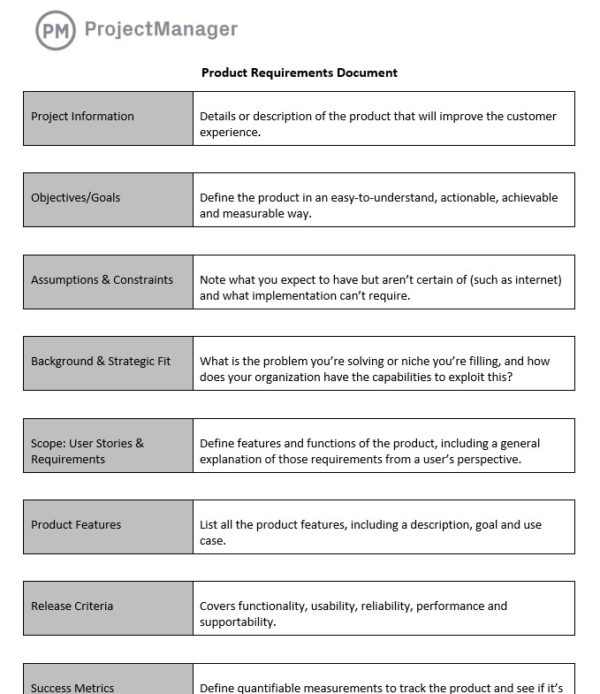
Personal Vision Statement
A vision statement isn’t restricted to the realm of industry, you can make one for your own purposes. A personal vision statement simply focuses on your personal values, strengths and goals. While you can use a personal vision statement for your professional life, it’s also commonly focused on life-long goals. As with any vision statement, use it to keep you on track and make the right decisions to direct you to that transformational achievement. Then, you should make an action plan to make your personal vision come true.
Vision Statement vs. Mission Statement
The vision statement and mission statement are both equally important for a company as they complement each other and guide the direction of your company. The main difference between them is that the mission statement describes what your company does, while your vision statement explains what the company attempts to achieve in the future.
On the other hand, their main similarity is that they both need to align with your company’s core values and culture because all these elements make up your company’s identity and differentiation factors.
Vision Statement vs. Purpose Statement
The vision statement comes before the purpose statement and it outlines where you want to be. First, you have to conjure it. You’re not there yet, but keeping the vision in sight allows you to get there in time. A purpose statement is the why, it’s the reason you want to achieve the vision that’s your goal. You have to answer the question of why you want to achieve this vision. Therefore, the purpose statement is about the overall values.
There’s also a mission statement, which often joins these other two statements. The mission statement is about how you’ll achieve your goals. This allows you to make a plan, create steps to implement it and track your progress towards achieving that vision statement.
30 Vision Statement Examples
The best way to learn about vision statements is to look at real-life vision statement examples. We’ve gathered 30 vision statement examples from the best companies in the world to help you write your own. These examples prove that a vision statement isn’t a templated document that only differs from other organizations by the branded logo on top of it.
1. IKEA
“Our vision is to create a better everyday life for many people.”

2. Nike
“Bring inspiration and innovation to every athlete* in the world. (*If you have a body, you are an athlete.)”

3. McDonald’s
“To be the best quick service restaurant experience. Being the best means providing outstanding quality, service, cleanliness and value, so that we make every customer in every restaurant smile.”

4. Amazon
“We strive to offer our customers the lowest possible prices, the best available selection and the utmost convenience.”
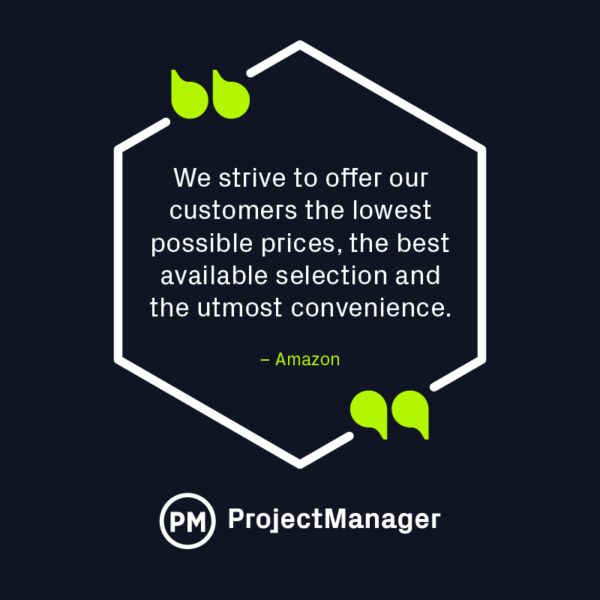
5. Walmart
“Be the destination for customers to save money, no matter how they want to shop.”

6. Google
“To provide access to the world’s information in one click.”
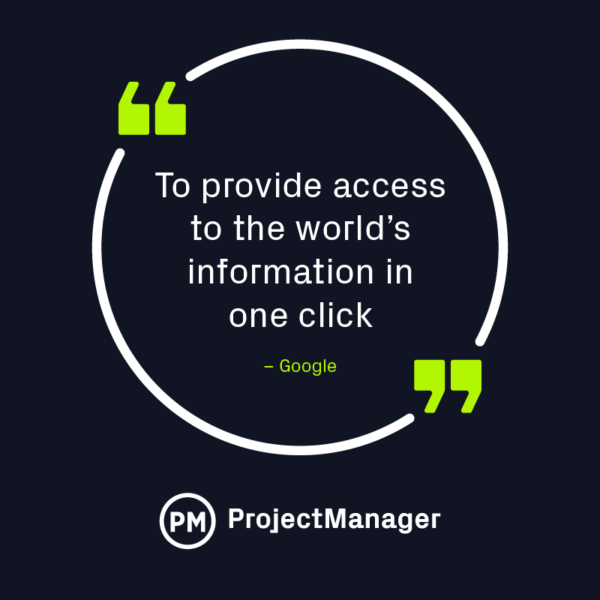
7. Microsoft
“To help people and businesses throughout the world realize their full potential.”

8. Facebook
“People use Facebook to stay connected with friends and family, to discover what’s going on in the world and to share and express what matters to them.”

9. Coca-Cola
“Our vision is to craft the brands and choice of drinks that people love, to refresh them in body and spirit.”

10. Starbucks
“Treat people like family, and they will be loyal and their all.”

11. Tesla
“To create the most compelling car company of the 21st century by driving the world’s transition to electric vehicles.”
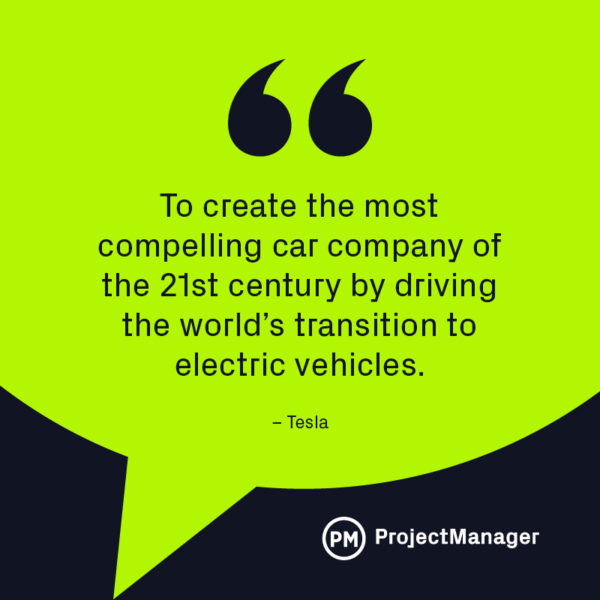
12. Samsung
“Inspire the world with our innovative technologies, products and design that enrich people’s lives and contribute to social prosperity.”

13. Netflix
“Becoming the best global entertainment distribution service.”
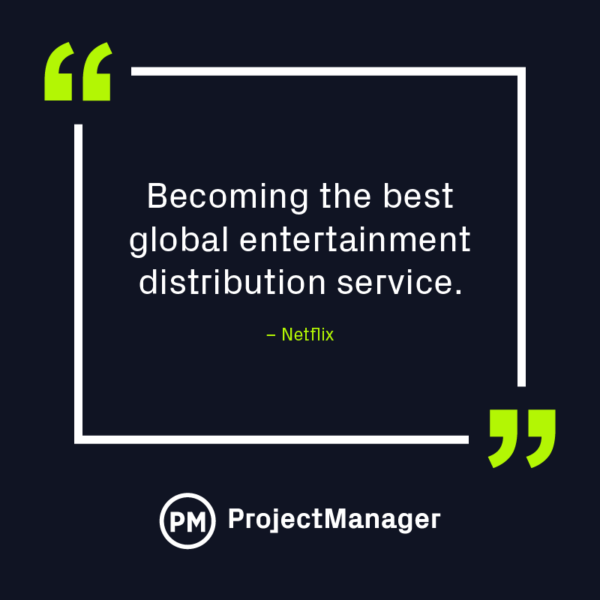
14. Zoom
“One platform delivering limitless human connection.”

15. Patagonia
“We’re in business to save our home planet.”

16. Oxfam
“A world without poverty.”

17. Disney
“To be one of the world’s leading producers and providers of entertainment and information.”
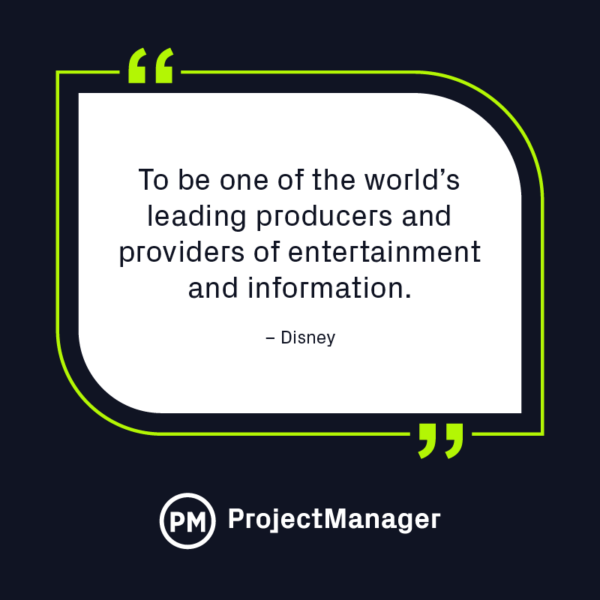
18. Instagram
“Capture and share the world’s moments.”

19. LinkedIn
“Create economic opportunity for every member of the global workforce.”

20. Meta
“Give people the power to build community and bring the world closer together.”

21. Shopify
“To make commerce better for everyone.”

22. Uber
“We ignite opportunity by setting the world in motion.”
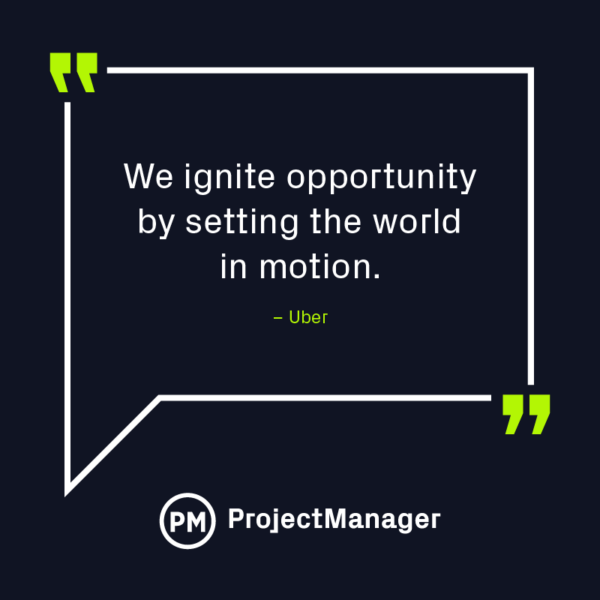
23. TED
“Spread ideas”

24. American Express
“Become essential to our customers by providing differentiated products and services to help them achieve their aspirations.”
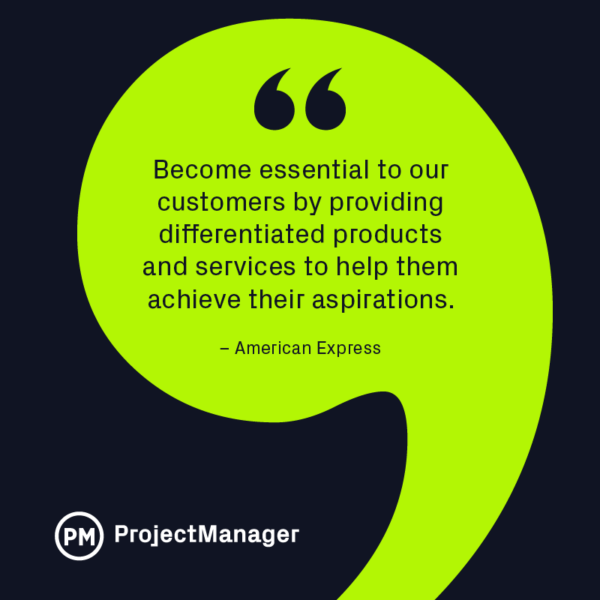
25. Sony
“To be a company that inspires and fulfills your curiosity.”

26. Whole Foods
“To nourish people and the planet.”

27. Lego
“A global force for Learning-through-Play.”

28. Kellogg’s
“A good and just world where people are not just fed but fulfilled.”

29. Southwest Airlines
“To be the world’s most loved, most efficient, and most profitable airline.”

30. Walgreens
“To be the leading partner in reimaging local healthcare and wellbeing for all.”

How to Write a Vision Statement
Every company has a unique vision statement, but the process is similar for most of them. Here are some steps to help you write your own.
1. What Are the Core Values of Your Company?
The core values of your company define its identity and how it interacts with the communities and the environment. It’s important to understand them to define your company vision and drive talent to the company.
2. What’s Your Company Mission?
Understanding what your company does and how it operates is essential to planning for the future.
3. Understand Your Company Culture
A strong company culture is an essential part of the success of any business. That’s why your vision must be aligned with it, otherwise, your strategic planning won’t work.
4. Identify Current Strategic Goals
Before you think about future goals, you must understand where your organization currently stands. Your vision might be a long-term plan that sets goals for the next 5 to 10 years, but those goals need to be realistic. You can use a SWOT matrix to get a better idea of the competitive environment of your business.
5. Define Future Goals
Think about what you’d like your company to achieve in the next 5-10 years based on the current status of your business and create a strategic plan to achieve your goals.
6. Write Your Vision Statement
Now that you have an idea of the main elements that are involved in the process of writing your vision statement, you can create one that fits your organization.
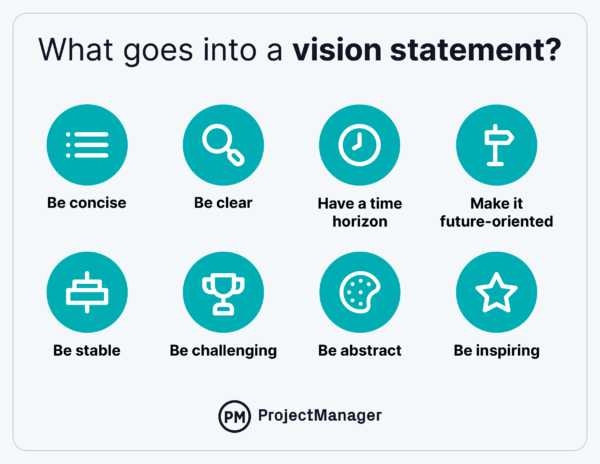
Best Practices for Writing a Vision Statement
There’s no template for writing a vision statement, however, a common structure for successful ones includes these traits:
- Be concise: This isn’t the place to stuff a document with fluff statements. It should be simple, easy to read and cut to the essentials so that it can be set to memory and be repeated accurately.
- Be clear: A good rule of thumb for clarity is to focus on one primary goal, rather than trying to fill the document with many ideas. One clear objective is also easier to focus on and achieve.
- Have a time horizon: A time horizon is simply a fixed point in the future when you’ll achieve and evaluate your vision statement. Define that timeline.
- Make it future-oriented: Again, the vision statement isn’t what the company is presently engaged in but rather a future objective of where the company plans to be.
- Be stable: The vision statement is a long-term goal that should, ideally, not be affected by the market or technological changes.
- Be challenging: That said, you don’t want to be timid in setting your goals. Your objective shouldn’t be too easy to achieve, but also it shouldn’t be so unrealistic as to be discarded.
- Be abstract: The vision statement should be general enough to capture the organization’s interests and strategic direction.
- Be inspiring: Live up to the title of the document, and create something that will rally the troops and be desirable as a goal for all those involved in the organization.
Because the vision statement is a foundational business document that will guide the company’s strategic planning direction for years to come, consider using project planning tools and brainstorming techniques to get input from everyone on the team. That way, you’ll get greater buy-in from the company, and you’ll widen your net for collecting business vision ideas.
Using ProjectManager to Write a Vision Statement
Writing a vision statement is a project in itself, and one that should be treated with some weight. A vision statement informs the direction, morale and spirit of the organization: you need it to be inspiring.
To help you craft the ideal vision statement, try ProjectManager. Our subscription model gives you several entry points. Then you can create collaborative task lists, so you can brainstorm with other leaders in the organization regarding your direction. Create a task, and add subtasks, so you can take everything into account when making your vision statement. Plus, you can add comments and files to tasks, so collaboration can stay focused and localized.

Once you’ve crafted a vision statement that inspires your team, the real work begins. To achieve that vision, you’ll need the right tools. ProjectManager is online project management software with tools like online Gantt charts, task lists and kanban boards to help you complete projects and make a name for yourself. Take a free trial of our award-winning software and see how it can help you realize your vision.

